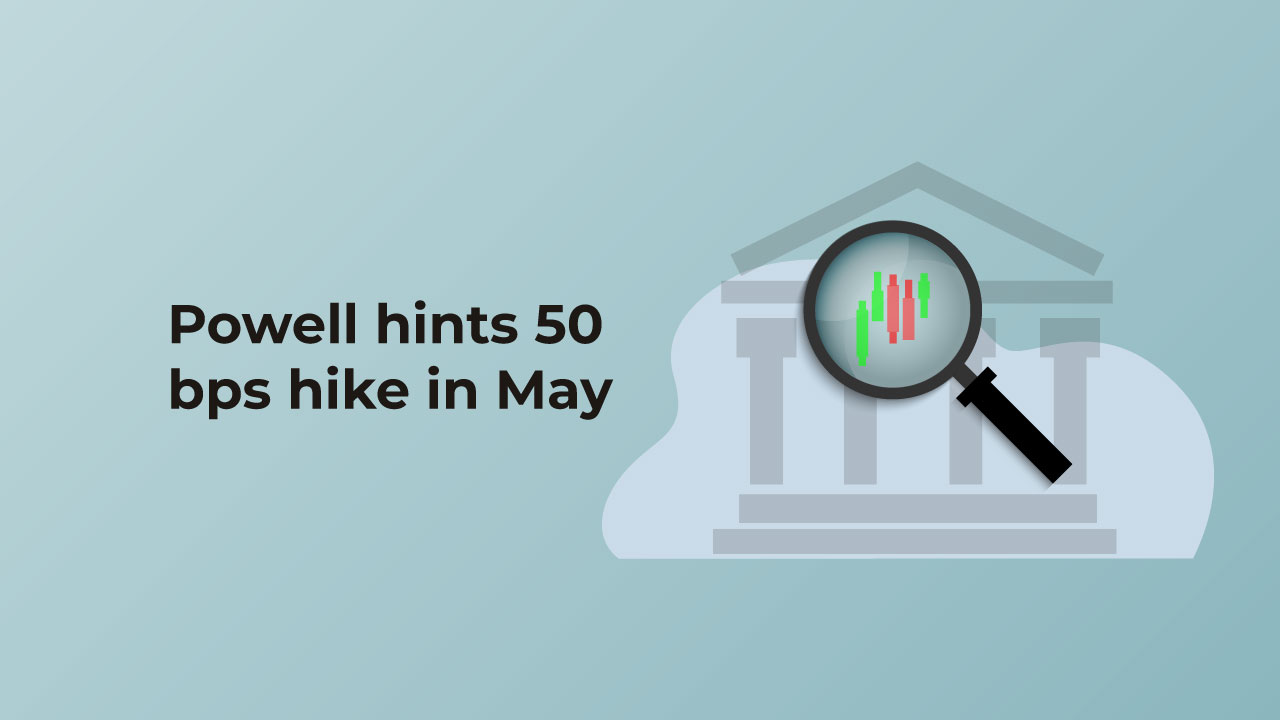Powell reinforces aggressive rate hike expectations

Last Updated: 25th April 2022 - 12:08 am
Ever since the US Department of Labour announced the Mar-22 consumer inflation at 8.5%, there have been sufficient hints that the Fed would hike rates by 50 bps at its 04th May FOMC meeting. Now there is official confirmation from Fed chairperson, Jerome Powell.
Speaking at the IMF Spring Meet 2022, Powell stated in no uncertain terms that the Fed would go ahead and hike rates by 50 bps in its May FOMC meeting. Here is what he said.
Gist of the Jerome Powell address at the IMF Spring 2022 meet
Talking on the future trajectory of rates, Powell has made some unambiguous statements on the monetary policy front.
Here is a quick take.
1. Fed rates would be hiked by 50 basis points in the 04th May meeting of the Federal Open Market Committee (FOMC). This will take the Fed rates from the range of 0.25%-0.50% to the range of 0.75% to 1.00%.
2. This will be the first time since the year 2006 that there would be two back-to-back hikes in interest rates. Remember that in March 2022, the Federal Open Market Committee (FOMC) had already hiked rates by 25 bps.
3. This will also be the first time since the year 2000 that the Fed would be increasing rates by 50 bps in one single go. All the subsequent rate hikes in the last 22 years have only been to the tune of 25 bps each.
4. In addition, Jerome Powell has also hinted that apart from the 04th May FOMC meet, the Fed would also hike rates by another 50 bps in the 15th June FOMC meet and probably have one more instance of 50 bps rate hike in the year 2022 itself.
5. That effectively moves up the likely interest rate target by the end of 2022 from the formerly envisaged level of 2.00%-2.25% to 2.75%-3.00%. That is a lot of hawkishness being built in.
6. Finally, Powell also made it clear in the IMF Spring 2022 meet that the Fed would use a double-barrelled approach. That is, apart from these aggressive rate hikes, they will start the bond book shrinkage at the rate of $95 billion per month from the month of May 2022 itself, without any hint of how long it would continue.
On the footsteps of Paul Volcker
Paul Volcker, the legendary Fed chairman from the late 1970s had adopted an aggressively hawkish approach to curb inflation. In the early 1980s, inflation had touched levels of 8-9%. To curb inflation, Paul Volcker went on a rate hiking spree which eventually led to controlling inflation. It also achieved two more things.
On the one hand, it lowered the expectations of inflation in the minds of people. Secondly, it got people out of the smug mindset that nothing could be done about high inflation levels.
Back in the early 1980s, inflation was a problem but two other problems did not exist. The bond book was much smaller because back then the Fed had not got used to printing money in a relentless manner to boost growth. Secondly, the global markets were not so inter-connected 4 decades back, as it is today.
Hence, today the risk of monetary divergence and constriction of capital flows are a lot more serious. Obviously, amidst his extremely hawkish stance, Powell will also have to keep these two issues at the back of his mind.
However, Powell does not appear willing to relent on his hawkishness. According to Powell, all the justifications for an aggressive rate hike cycle are there. Firstly, consumer inflation at 8.5% is 650 bps above the Fed comfort level. Secondly, US revival in GDP growth may still not be even, but it is now above pre-COVID levels.
Lastly, Powell points that unemployment had fallen from 5.6% in Jun-21 to 3.6% in Mar-22. Since wage inflation is also feeding into consumer inflation, Powell considers it the right time to get aggressive on rates.
What does this mean for India?
If the Fed sticks to its 50 bps promise of May then the RBI options would reduce drastically. It cannot continue to risk divergence when the US is ultra-hawkish. That will have its implications for Indian capital flows. However, one positive factor for India is that ECB has still kept its rates near Zero despite 7.5% inflation.
Europe does not want to risk a hard landing in the current situation and is willing to risk monetary divergence. Of course, Europe has a justification since its growth is likely to shrink substantially due to the Ukraine war.
India needs to steady growth and it also needs to steady inflation. Amidst this dilemma, the ECB stance may largely neutralize America’s plans on the monetary policy.
The fact of the matter is that monetary divergence is not something even the US would want to risk beyond a point. Hence, Fed staying hawkish while ECB focuses on growth is not exactly feasible. For now, it looks like 50 bps in May will happen as there is too much reputation at stake. Beyond May, it would be monetary convergence that will matter more.
- Flat ₹20 Brokerage
- Next-gen Trading
- Advance Charting
- Actionable Ideas
Trending on 5paisa
Disclaimer: Investment in securities market are subject to market risks, read all the related documents carefully before investing. For detailed disclaimer please Click here.
 5paisa Research Team
5paisa Research Team